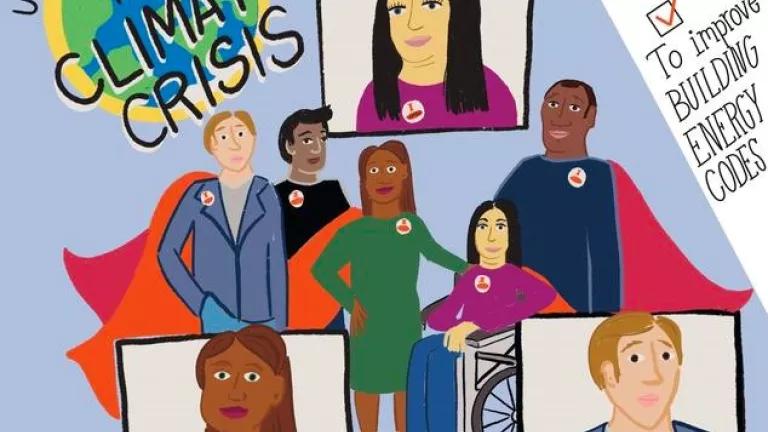
It’s go time!
We’ve been writing all this year about the development of the 2021 International Energy Conservation Code for residential and commercial buildings– from submitting proposals, to presenting residential and commercial proposals at the Committee Action Hearings in Albuquerque, to revising and re-presenting them recently at the Public Comment Hearings in Las Vegas. Now, it’s showtime for government officials—the final decision-makers in the code process.
Online voting is now open to determine which proposals make the cut and become a part of the nation’s next model energy code and lasts through December 6. Only registered governmental members of the International Code Council are eligible to vote. But many potential voters don’t even know they have this opportunity to fulfill their locality’s climate commitments and fail to vote or fail to consider the climate importance of their vote.
Why is this so important? Buildings and the energy they use emit about 40 percent of U.S. carbon emissions. Once they’re constructed, buildings last a long time—60 to 100 years or more. It’s cheapest, easiest, and makes the most sense to build buildings right the first time. And we know how to do it! To solve the climate crisis, we need buildings to use far less energy and to be operated with clean, renewable power. An updated, improved building code is a commonsense way to address this issue in new buildings. Government officials have the power to be climate heroes by voting right!
The voting guides
A strong model energy code is absolutely essential to reduce energy use in new buildings, make home ownership more affordable, and reduce climate-warming carbon pollution from buildings. The code covers everything from insulation levels to windows to air leakage, and has made a huge difference in the energy efficiency of new buildings.
However, untangling the model code development process can be daunting! To make it as easy as possible for government officials to have their say, NRDC, as part of the Energy Efficient Codes Coalition (EECC), worked with energy efficiency supporters--including advocacy groups, low-income housing organizations, states, cities, and others--to develop handy voting guides for the government officials who can vote on the code. Following the recommendations in the guides ill result in new buildings that use at least 10 percent less energy than the current code and will set us well on the way to net-zero new construction by 2050.
For government officials who will be casting votes, we thank you and offer this information about our two voting guides to reference:
1. Quick Voting Guide
The easiest way to vote is to print out the quick voting guide and go straight down the list, checking off the boxes as you vote. While this may look like a lot of proposals, once you get going, we expect it should only take you about an hour to get through them all!
A few things to note:
- You’ll have two voting options for each proposal: to approve the proposal under consideration or to disapprove it. For proposals to approve, you may be voting on whether to approve as submitted (AS), as modified by the committee (AM), or as modified by the public comment (AMPC1, AMPC2, etc., as there were often multiple public comments under consideration). Don’t worry: we spelled all this out clearly in the voting guides, so if you follow the recommendations you’ll be set!
- Voting to DISAPPROVE certain proposals is as important as voting to approve others. A number of the proposals in play would roll back the efficiency of the code, moving in the wrong direction. Voting against them helps protect the integrity of our nation’s model code.
- We don’t make recommendations on every single proposal, because some of the other proposals don’t have much impact on the efficiency of the code. There will be more proposals on your screen than in these voting guides, so take care to make sure you’re voting on the correct proposal.
- If you’d like more information about why we did or didn’t make recommendations for specific proposals, or need any other kind of voting help, don’t hesitate to reach out to the Energy Efficient Codes Coalition at EECC@ase.org.
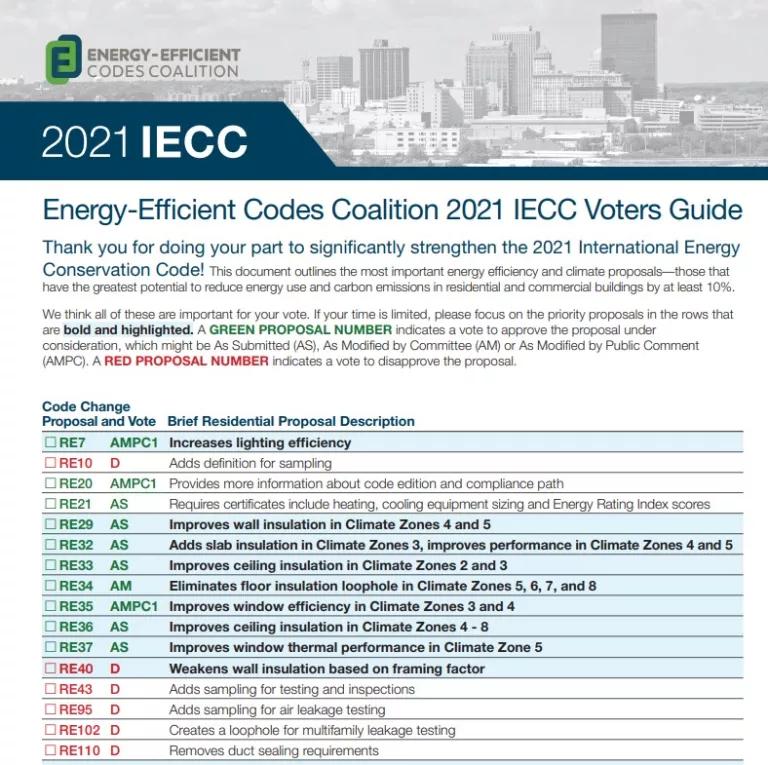
2. Residential and Commercial Detailed Voting Guides
If you’re looking for more details about each proposal, including how the technical committee voted on the proposal, how the public comment hearing vote went, and a brief analysis of our recommendation, review the more detailed voting guides. We have one for residential proposals and one for commercial proposals because the ballots are separate. The voting recommendations are consistent between the quick guide and the detailed guides.
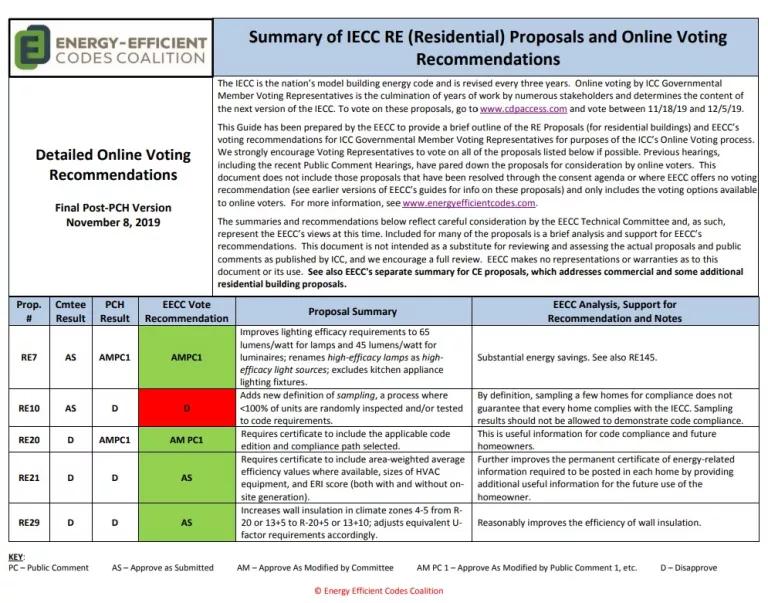
How do I vote?
Before You Vote: To save time when voting, log into CDP Access in advance. If you have trouble logging in, you can reset your PIN in the same place as “reset password.” If you still have trouble, check with your Primary Representative (the person in your office that registered you to vote), and confirm that he/she used your correct email address when registering you as a governmental member voting representative (GMVR).
To Vote
We recommend you watch this great video from the ICC, which will give you step-by-step instructions on how to vote.
1. Log on to CDPAccess (www.cdpaccess.com) and click the “Current Cycle” drop down button
2. Click on “OGCV Votes”
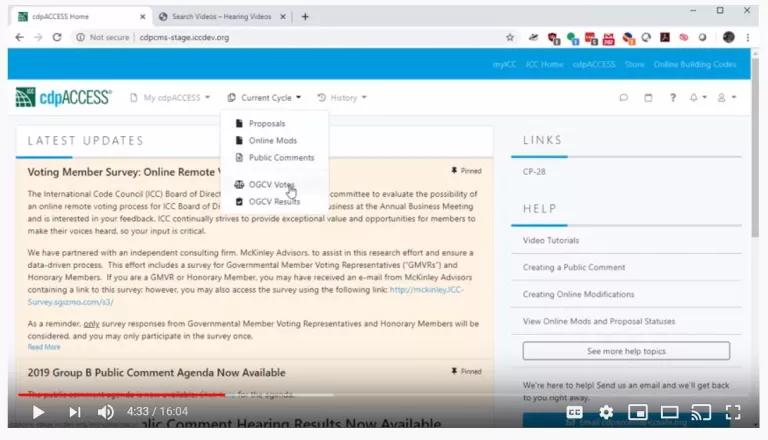
3. Click on the “Subject Matter” drop down button and navigate to CE – Energy – Commercial (for the IECC Commercial proposals) or RE – Energy – Residential (for the IECC Residential proposals).
(Note: you can also sort by which hearing committee heard the original proposal, but be aware that the residential committee heard some of the CE proposals, and vice versa. We recommend you search by subject matter, as that will be consistent with the EECC voting guides for residential and commercial proposals).
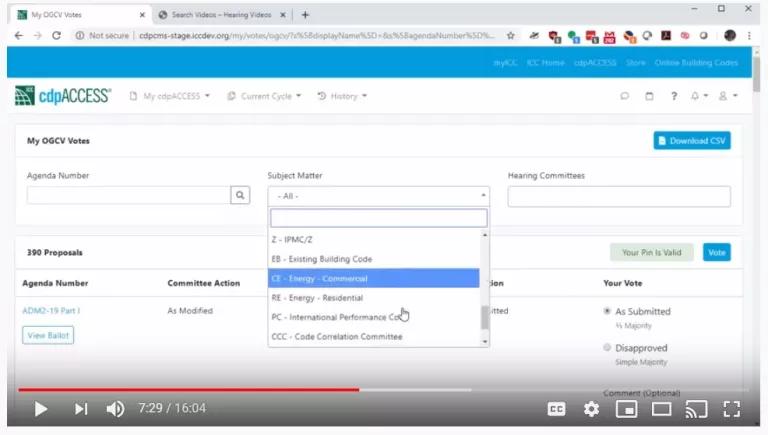
4. Make your selections, using the EECC Voting Guides. There should be about 20 proposals per page.
5. If you want more information about a proposal, you use the detailed EECC residential and commercial voting guides, or can click on “View Ballot” underneath each proposal number.
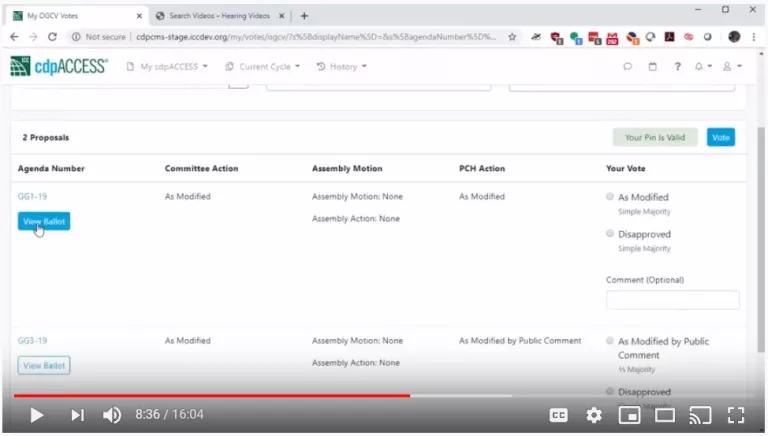
5. Hit “VOTE” when you get to the end of each page. The first time you hit the vote button, you’ll be asked for your 4-digit PIN. Your PIN is valid for 30 minutes, then you’ll be prompted to enter it again.
6. Continue through all the pages until all your votes are cast! Remember to vote for residential AND commercial proposals, by toggling through the “Subject Matter” drop-down button.
And more!
If this is your first time voting on the IECC, you’re not alone! There’s more interest in the code development process than ever before. There are lots of additional resources available to help. They’re conveniently housed on the Energy Efficient Codes Coalition website and include a First-Time Voters Webinar, the ICC's How-to-Vote Video and a forthcoming “watch me vote” video with the City of Boston (we’ll link that here once it’s available).
Still need more help? Don’t hesitate to get in touch with us, or with EECC directly at EECC@ase.org.
Thank you for taking the time to make your voice heard—and the Earth will thank you, too.


